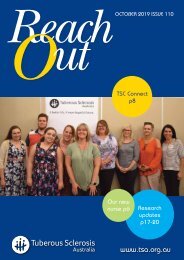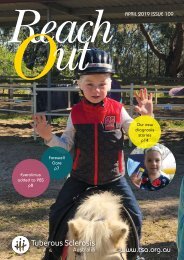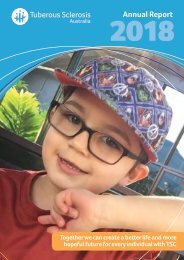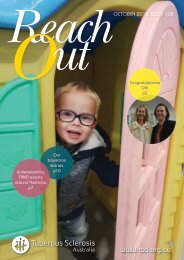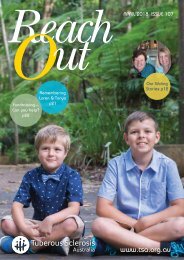Tuberous Sclerosis Australia Reach Out Magazine October 2016
You also want an ePaper? Increase the reach of your titles
YUMPU automatically turns print PDFs into web optimized ePapers that Google loves.
Personal Stories<br />
Personal Stories<br />
Sophie’s Story<br />
Georgina Schilg, Sophie’s Mum<br />
Ariela’s Story<br />
Chelli Edri, Ariela’s mum<br />
Ariela was suspected of TSC at birth due to multiple white<br />
patches (hypomelanotic macules) on her skin. She wasn’t<br />
presenting with any other symptoms and TSC wasn’t even<br />
mentioned until she was about eight weeks old. It was really just<br />
a waiting game to see what would present.<br />
When Ariela was three months old her kidneys were checked<br />
and all was fine and talk of multiple birth marks started. At six<br />
months, a heart tuber was found. I sought a second opinion on her<br />
skin and consulted a geneticist on the possibility of TSC. Because<br />
Ariela seemed perfectly healthy, I had to wait until she was over<br />
two for an MRI to confirm if it was in fact TSC or not. At 2.5<br />
years, the MRI confirmed tuberous sclerosis complex with the<br />
presence of a SEGA and tubers.<br />
One of the hardest things I have found with TSC is not knowing<br />
how things will play out, and at the same time, knowing I am<br />
making potentially life changing decisions for my child. It’s a huge<br />
responsibility. I have to weigh up impacts on her quality of life with<br />
potential benefits of treatment.<br />
For any parent with a child presenting minor or occasional<br />
seizures who meets all their milestones it is hard to know the best<br />
course of action and even harder for specialists to advocate one<br />
option over another. While medication was presented as a possible<br />
option as soon as the SEGA was discovered, at the time it was a<br />
borderline option due to minimal symptoms; so at that point, I<br />
chose to protect her quality of life.<br />
From the very day Ariela was formally diagnosed, I stopped<br />
leaving her in the care of paid babysitters and became extremely<br />
careful who, out of my close family and friends would mind her<br />
when I wasn’t around. Having a child who may be having seizures<br />
is a massive responsibility especially as some of the seizures are<br />
hard to identify. This puts a lot of pressure on any carer.<br />
As Ariela has gotten older, she has developed mild autism<br />
yet seizures are rare. For this reason, I still feel as if I am in the<br />
calm before the storm and we are waiting for our next EEG to<br />
see if there is new seizure activity or not. I say we, as when you<br />
are a parent, what happens to your child is actually happening<br />
to you at the same time.<br />
TSC also becomes tricky when considering how much<br />
information to disclose to daycare providers. I still remember<br />
One of the hardest things I have<br />
found with TSC is not knowing how<br />
things will play out<br />
the day I explained to the staff at her current daycare what<br />
TSC was, what a possible seizure might look like, and that<br />
they could call me any time if they suspected anything. The<br />
Director initially was quite concerned and, as a result, I spent a<br />
lot of time being available and around when she first stated to<br />
make sure the staff were ok with her. I still spend time there on<br />
a regular basis.<br />
Ariela is a very happy little girl who is always laughing<br />
and really enjoys life. She is not old enough to know about<br />
her condition, so for now I’m just thankful hospitals have<br />
such great play areas and toys. I hope we never get to the stage<br />
where we need to consider medication or surgery however as<br />
optimistic as I am, I realise if seizures become frequent or if<br />
our next MRI shows her SEGA has grown, we will have to. So<br />
right now we are in the calm before the next TSC storm, and<br />
have no idea what the future holds.<br />
Our Sophie is eight years old and began having seizures at<br />
nine months of age. These were our first indication that<br />
something was wrong and so began our journey into the world<br />
of <strong>Tuberous</strong> <strong>Sclerosis</strong> Complex and Epilepsy. Since then Sophie<br />
has been on several different medications to control her seizures,<br />
had multiple EEGs, done several video EEG stays and has had<br />
neurosurgery to remove several tubers.<br />
We live in northern Tasmania, where there are no resident<br />
paediatric neurologists. For the past three years we have gained<br />
the services of a paediatric neurologist based in Hobart who<br />
travels to Launceston every so often, and prior to this we relied on<br />
neurology clinics at Royal Children’s Hospital Melbourne. Thus<br />
we have made many trips to Melbourne for various appointments,<br />
reviews, tests and surgery.<br />
Sophie is aware of her seizures<br />
and has an aura before the onset of her<br />
regular seizure type.<br />
Sophie suffers complex partial seizures. Medications control<br />
her seizures quite well at present, and she is lucky in that she<br />
does not suffer too much from the potential side effects of these,<br />
although it is something that we continue to observe for. In<br />
particular we continue to have regular ophthalmology reviews<br />
and yearly electro-retinography to monitor any decrease in her<br />
visual fields as a result of one of the medications she takes, called<br />
Sabril (vigabatrin).<br />
Epilepsy is something we live with every day. We are very<br />
thankful that Sophie is happy to take her two medicines twice<br />
each day. We talk to her younger brother about Sophie’s seizures,<br />
about seizure safety and how he can help her if need be. Sophie<br />
is aware of her seizures and has an aura before the onset of her<br />
regular seizure type. Sometimes when tucking her into bed, she<br />
will ask if she will have a seizure that night, and comment that she<br />
does not like seizures. These questions are hard to answer – there<br />
is no knowing when the next seizure will be, or how long it will go<br />
for, and yet she remains brave and simply gets on with life.<br />
Sophie’s epilepsy means that I am extra cautious about<br />
leaving her places, as I need to ensure the other responsible adults<br />
are aware of the potential for a seizure, and to ensure that they<br />
are confident in managing this. It also means I am particularly<br />
cautious with activities such as swimming. However, Sophie’s<br />
epilepsy and TSC does not stop her from trying most things.<br />
She loves riding her bike and scooter, enjoys dancing and<br />
running and will give anything a go.<br />
8<br />
<strong>Reach</strong><br />
<strong>Out</strong><br />
OCTOBER <strong>2016</strong> ISSUE 104<br />
9





![TSA Reach Out April 2022 [Final]](https://documents.yumpu.com/000/066/687/587/3d369bd665bdb406a759500f62e2cfad0ccb7b3d/47512b4a703265727550565249426664566a727454513d3d/396a524e7354316d3867454b587243526164724c52673d3d.jpg?AWSAccessKeyId=AKIAICNEWSPSEKTJ5M3Q&Expires=1714366800&Signature=C%2Bl97hOMS36f0ktcNepYi4B8VME%3D)
![TSA AR 2021 [WEB] (1)_FINAL](https://documents.yumpu.com/000/065/886/431/1afb21934ac6c444cd384e5fd7403d62e47080ce/426853747566526573646568546777594b4a4a5734513d3d/547274595943503850786275754544495972536c52513d3d.jpg?AWSAccessKeyId=AKIAICNEWSPSEKTJ5M3Q&Expires=1714366800&Signature=kfvdaWIqdwnrgh3bxu%2B5wkKhqkQ%3D)

![TSA Reach Out Apr 2021 [WEB]](https://documents.yumpu.com/000/065/442/909/1e583cb2acba0eaa7f1aae53e14a0cf408aa56c4/7871796d694459464d707163324830746459484671673d3d/45356637637a3369494f764f4c3858495549795251513d3d.jpg?AWSAccessKeyId=AKIAICNEWSPSEKTJ5M3Q&Expires=1714366800&Signature=exwJsPY3vqRm96LaIg0XLshixJ8%3D)




